Up to date
This page is up to date for Godot 4.2.
If you still find outdated information, please open an issue.
Používání signálů¶
In this lesson, we will look at signals. They are messages that nodes emit when something specific happens to them, like a button being pressed. Other nodes can connect to that signal and call a function when the event occurs.
Signals are a delegation mechanism built into Godot that allows one game object to react to a change in another without them referencing one another. Using signals limits coupling and keeps your code flexible.
For example, you might have a life bar on the screen that represents the player's health. When the player takes damage or uses a healing potion, you want the bar to reflect the change. To do so, in Godot, you would use signals.
Poznámka
Jak bylo zmíněno v úvodu, signály jsou Godotovou verzí vzoru pozorovatel (observer). Více se o něm můžete dozvědět zde: https://gameprogrammingpatterns.com/observer.html
We will now use a signal to make our Godot icon from the previous lesson (Listening to player input) move and stop by pressing a button.
Nastavení scény¶
To add a button to our game, we will create a new main scene which will include
both a Button and the sprite_2d.tscn scene we created in
the Vytvoření prvního skriptu lesson.
Create a new scene by going to the menu Scene -> New Scene.
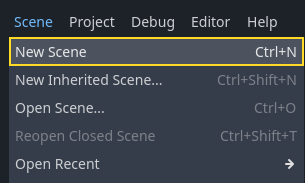
In the Scene dock, click the 2D Scene button. This will add a Node2D as our root.
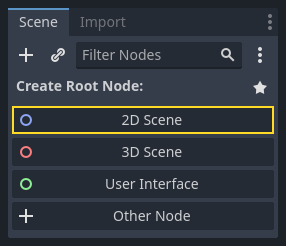
In the FileSystem dock, click and drag the sprite_2d.tscn file you saved
previously onto the Node2D to instantiate it.

We want to add another node as a sibling of the Sprite2D. To do so, right-click on Node2D and select Add Child Node.
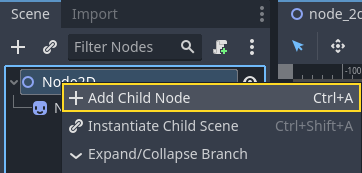
Search for the Button node and add it.
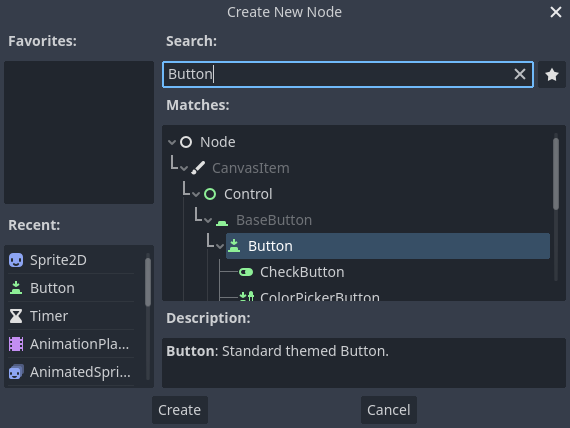
The node is small by default. Click and drag on the bottom-right handle of the Button in the viewport to resize it.

If you don't see the handles, ensure the select tool is active in the toolbar.

Click and drag on the button itself to move it closer to the sprite.
You can also write a label on the Button by editing its Text property in the
Inspector. Enter Toggle motion.
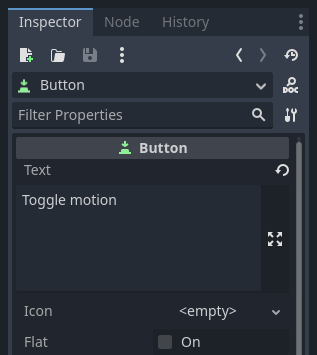
Strom scény a okno zobrazení by měly vypadat takto.

Save your newly created scene as node_2d.tscn, if you haven't already.
You can then run it with F6 (Cmd + R on macOS).
At the moment, the button will be visible, but nothing will happen if you
press it.
Připojení signálu v editoru¶
Here, we want to connect the Button's "pressed" signal to our Sprite2D, and we want to call a new function that will toggle its motion on and off. We need to have a script attached to the Sprite2D node, which we do from the previous lesson.
You can connect signals in the Node dock. Select the Button node and, on the right side of the editor, click on the tab named "Node" next to the Inspector.
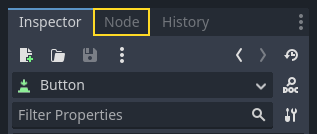
The dock displays a list of signals available on the selected node.
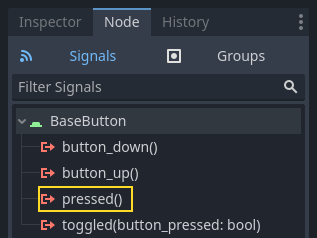
Double-click the "pressed" signal to open the node connection window.
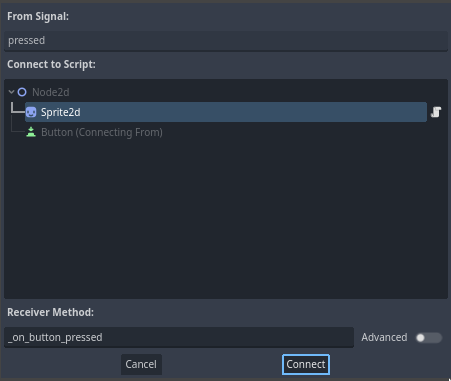
There, you can connect the signal to the Sprite2D node. The node needs a receiver method, a function that Godot will call when the Button emits the signal. The editor generates one for you. By convention, we name these callback methods "_on_node_name_signal_name". Here, it'll be "_on_button_pressed".
Poznámka
When connecting signals via the editor's Node dock, you can use two modes. The simple one only allows you to connect to nodes that have a script attached to them and creates a new callback function on them.
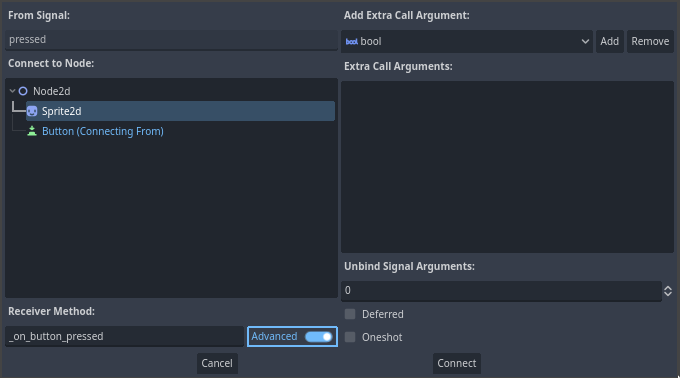
The advanced view lets you connect to any node and any built-in function, add arguments to the callback, and set options. You can toggle the mode in the window's bottom-right by clicking the Advanced button.
Click the Connect button to complete the signal connection and jump to the Script workspace. You should see the new method with a connection icon in the left margin.
If you click the icon, a window pops up and displays information about the connection. This feature is only available when connecting nodes in the editor.
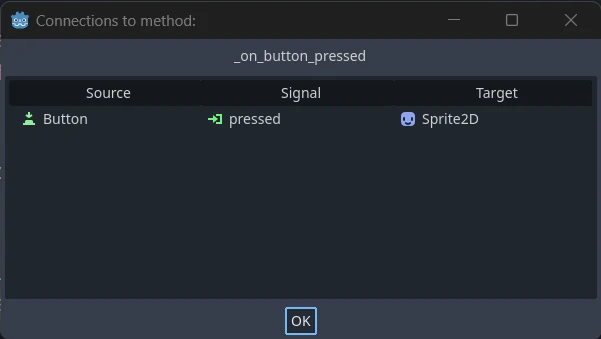
Let's replace the line with the pass keyword with code that'll toggle the
node's motion.
Our Sprite2D moves thanks to code in the _process() function. Godot provides
a method to toggle processing on and off: Node.set_process(). Another method of the Node class,
is_processing(), returns true if idle processing is active. We can use
the not keyword to invert the value.
func _on_button_pressed():
set_process(not is_processing())
private void OnButtonPressed()
{
SetProcess(!IsProcessing());
}
This function will toggle processing and, in turn, the icon's motion on and off upon pressing the button.
Before trying the game, we need to simplify our _process() function to move
the node automatically and not wait for user input. Replace it with the
following code, which we saw two lessons ago:
func _process(delta):
rotation += angular_speed * delta
var velocity = Vector2.UP.rotated(rotation) * speed
position += velocity * delta
public override void _Process(double delta)
{
Rotation += _angularSpeed * (float)delta;
var velocity = Vector2.Up.Rotated(Rotation) * _speed;
Position += velocity * (float)delta;
}
Your complete sprite_2d.gd code should look like the following.
extends Sprite2D
var speed = 400
var angular_speed = PI
func _process(delta):
rotation += angular_speed * delta
var velocity = Vector2.UP.rotated(rotation) * speed
position += velocity * delta
func _on_button_pressed():
set_process(not is_processing())
using Godot;
public partial class MySprite2D : Sprite2D
{
private float _speed = 400;
private float _angularSpeed = Mathf.Pi;
public override void _Process(double delta)
{
Rotation += _angularSpeed * (float)delta;
var velocity = Vector2.Up.Rotated(Rotation) * _speed;
Position += velocity * (float)delta;
}
private void OnButtonPressed()
{
SetProcess(!IsProcessing());
}
}
Spusťte nyní scénu a klikněte na tlačítko, abyste viděli, jak se sprite spouští a zastavuje.
Připojení signálů v kódu¶
You can connect signals via code instead of using the editor. This is necessary when you create nodes or instantiate scenes inside of a script.
Let's use a different node here. Godot has a Timer node that's useful to implement skill cooldown times, weapon reloading, and more.
Head back to the 2D workspace. You can either click the "2D" text at the top of the window or press Ctrl + F1 (Ctrl + Cmd + 1 on macOS).
In the Scene dock, right-click on the Sprite2D node and add a new child node. Search for Timer and add the corresponding node. Your scene should now look like this.
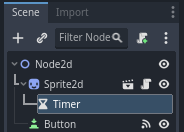
With the Timer node selected, go to the Inspector and enable the Autostart property.

Click the script icon next to Sprite2D to jump back to the scripting workspace.
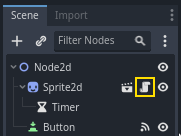
We need to do two operations to connect the nodes via code:
Get a reference to the Timer from the Sprite2D.
Call the
connect()method on the Timer's "timeout" signal.
Poznámka
To connect to a signal via code, you need to call the connect()
method of the signal you want to listen to. In this case, we want to
listen to the Timer's "timeout" signal.
We want to connect the signal when the scene is instantiated, and we can do that using the Node._ready() built-in function, which is called automatically by the engine when a node is fully instantiated.
To get a reference to a node relative to the current one, we use the method Node.get_node(). We can store the reference in a variable.
func _ready():
var timer = get_node("Timer")
public override void _Ready()
{
var timer = GetNode<Timer>("Timer");
}
The function get_node() looks at the Sprite2D's children and gets nodes by
their name. For example, if you renamed the Timer node to "BlinkingTimer" in the
editor, you would have to change the call to get_node("BlinkingTimer").
We can now connect the Timer to the Sprite2D in the _ready() function.
func _ready():
var timer = get_node("Timer")
timer.timeout.connect(_on_timer_timeout)
public override void _Ready()
{
var timer = GetNode<Timer>("Timer");
timer.Timeout += OnTimerTimeout;
}
The line reads like so: we connect the Timer's "timeout" signal to the node to
which the script is attached. When the Timer emits timeout, we want to call
the function _on_timer_timeout(), that we need to define. Let's add it at the
bottom of our script and use it to toggle our sprite's visibility.
Poznámka
By convention, we name these callback methods in GDScript as "_on_node_name_signal_name" and in C# as "OnNodeNameSignalName". Here, it'll be "_on_timer_timeout" for GDScript and OnTimerTimeout() for C#.
func _on_timer_timeout():
visible = not visible
private void OnTimerTimeout()
{
Visible = !Visible;
}
The visible property is a boolean that controls the visibility of our node.
The line visible = not visible toggles the value. If visible is
true, it becomes false, and vice-versa.
If you run the scene now, you will see that the sprite blinks on and off, at one second intervals.
Kompletní skript¶
That's it for our little moving and blinking Godot icon demo!
Here is the complete sprite_2d.gd file for reference.
extends Sprite2D
var speed = 400
var angular_speed = PI
func _ready():
var timer = get_node("Timer")
timer.timeout.connect(_on_timer_timeout)
func _process(delta):
rotation += angular_speed * delta
var velocity = Vector2.UP.rotated(rotation) * speed
position += velocity * delta
func _on_button_pressed():
set_process(not is_processing())
func _on_timer_timeout():
visible = not visible
using Godot;
public partial class MySprite2D : Sprite2D
{
private float _speed = 400;
private float _angularSpeed = Mathf.Pi;
public override void _Ready()
{
var timer = GetNode<Timer>("Timer");
timer.Timeout += OnTimerTimeout;
}
public override void _Process(double delta)
{
Rotation += _angularSpeed * (float)delta;
var velocity = Vector2.Up.Rotated(Rotation) * _speed;
Position += velocity * (float)delta;
}
private void OnButtonPressed()
{
SetProcess(!IsProcessing());
}
private void OnTimerTimeout()
{
Visible = !Visible;
}
}
Vlastní signály¶
Poznámka
This section is a reference on how to define and use your own signals, and does not build upon the project created in previous lessons.
You can define custom signals in a script. Say, for example, that you want to show a game over screen when the player's health reaches zero. To do so, you could define a signal named "died" or "health_depleted" when their health reaches 0.
extends Node2D
signal health_depleted
var health = 10
using Godot;
public partial class MyNode2D : Node2D
{
[Signal]
public delegate void HealthDepletedEventHandler();
private int _health = 10;
}
Poznámka
As signals represent events that just occurred, we generally use an action verb in the past tense in their names.
Your signals work the same way as built-in ones: they appear in the Node tab and you can connect to them like any other.
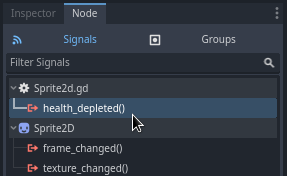
To emit a signal in your scripts, call emit() on the signal.
func take_damage(amount):
health -= amount
if health <= 0:
health_depleted.emit()
public void TakeDamage(int amount)
{
_health -= amount;
if (_health <= 0)
{
EmitSignal(SignalName.HealthDepleted);
}
}
Signál může také volitelně deklarovat jeden nebo více argumentů. Názvy argumentů zadejte mezi závorkami:
extends Node
signal health_changed(old_value, new_value)
var health = 10
using Godot;
public partial class MyNode : Node
{
[Signal]
public delegate void HealthChangedEventHandler(int oldValue, int newValue);
private int _health = 10;
}
Poznámka
Argumenty signálu se zobrazují v doku Uzel editoru a Godot je pro vás může použít k vytvoření funkcí zpětného volání. Při vysílání signálů však stále můžete vysílat signály s libovolným počtem argumentů. Je tedy na vás, abyste vyslali ty správné hodnoty.
To emit values along with the signal, add them as extra arguments to the
emit() function:
func take_damage(amount):
var old_health = health
health -= amount
health_changed.emit(old_health, health)
public void TakeDamage(int amount)
{
int oldHealth = _health;
_health -= amount;
EmitSignal(SignalName.HealthChanged, oldHealth, _health);
}
Shrnutí¶
Any node in Godot emits signals when something specific happens to them, like a button being pressed. Other nodes can connect to individual signals and react to selected events.
Signals have many uses. With them, you can react to a node entering or exiting the game world, to a collision, to a character entering or leaving an area, to an element of the interface changing size, and much more.
Mnoho vestavěných typů uzlů Godota poskytuje signály, které můžete použít pro detekci událostí. Například Area2D představující minci vydává signál body_entered, kdykoli tělo hráče (uzel Physicsbody) vstoupí do jejího kolizního tvaru, což vám umožní zaznamenat okamžik, kdy hráč minci sebere.
V následující sekci Vaše první 2D hra vytvoříte kompletní hru,která ukáže využití signálů pro vzájené spojení různých herních komponent.